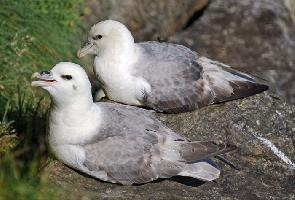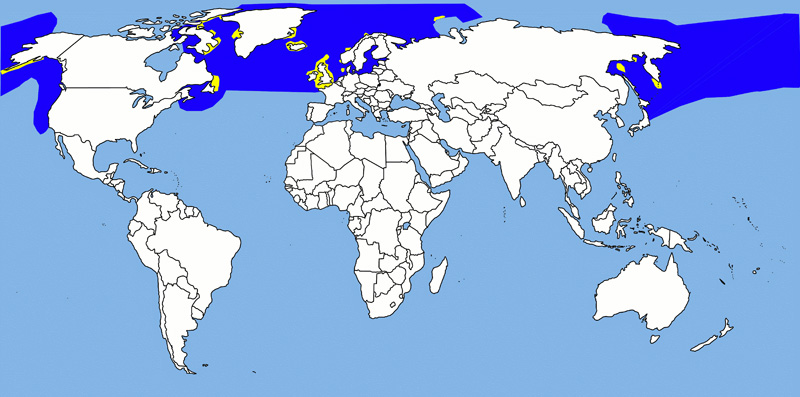
Poids et mesures
| Longueur | de 43 à 52 cm |
|---|---|
| Poids | de 700 à 850 g |
| Envergure des ailes | de 101 à 117 cm |
Description de l'animal
The Northern Fulmar (Fulmarus glacialis) is a captivating seabird that belongs to the family Procellariidae, which includes other petrels and shearwaters. This species exhibits a remarkable blend of elegance and resilience, thriving in the harsh conditions of the North Atlantic and Arctic Oceans. The Northern Fulmar's appearance, behavior, and ecological role make it a fascinating subject of study and observation.Physical Description
The Northern Fulmar is a medium-sized bird, measuring about 46 cm in length with a wingspan that can reach up to 102 cm. It possesses a sturdy body, a relatively small head, and a thick neck, which give it a robust appearance. The bird's plumage varies from individual to individual, ranging from an almost entirely white body with a light gray back to darker forms that are uniformly gray. Its wings are long and narrow, designed for efficient gliding over the ocean surface. The Northern Fulmar has a short, stout bill that is pale yellow to light pink, equipped with tubular nostrils that are characteristic of the Procellariidae family. These nostrils are an adaptation for excreting excess salt, as the bird ingests a lot of seawater while feeding.
Habitat and Distribution
The Northern Fulmar is found primarily in the northern regions of the Atlantic and Arctic Oceans. It breeds on rocky, cliff-bound coasts and islands, preferring sites that offer protection from predators and easy access to the sea. Outside the breeding season, fulmars are highly pelagic, spending most of their life on the open ocean. They are known to roam vast distances across their range, which stretches from the northeastern coast of North America across Greenland, Iceland, and northern Europe to the coasts of Russia in the east.
Diet and Feeding Habits
As opportunistic feeders, Northern Fulmars have a varied diet that includes fish, squid, crustaceans, and jellyfish. They are also known to scavenge on carrion and waste from ships. Fulmars employ different feeding techniques such as surface seizing, dipping into the water while in flight, and occasionally diving to pursue prey just below the water's surface. Their ability to detect food sources is enhanced by their keen sense of smell, a trait not common among all bird species.
Reproduction and Lifecycle
Northern Fulmars are monogamous birds that form long-lasting pair bonds. They return to the same breeding sites year after year, where they engage in elaborate courtship displays that involve mutual preening, bill clicking, and synchronized flight. The female lays a single white egg in a nest built on a ledge or crevice with minimal vegetation. Both parents share incubation duties for about 50 to 60 days. After hatching, the chick is fed a rich diet of fish oil regurgitated by its parents, allowing it to grow rapidly. Fledging occurs approximately 7 to 8 weeks after hatching, but juveniles may remain dependent on their parents for several more weeks.
Conservation Status
Currently, the Northern Fulmar is considered to be of Least Concern by the International Union for Conservation of Nature (IUCN), thanks to its large and stable population. However, the species faces threats from pollution, particularly plastic ingestion and oil spills, which can have devastating effects on individual birds and potentially on the population as a whole. Climate change also poses a long-term threat by altering the distribution of sea ice and affecting the availability of prey species.
Conclusion
The Northern Fulmar is a remarkable bird, well adapted to life in the challenging conditions of the northern oceans. Its graceful flight, complex social behaviors, and ecological significance make it an important and intriguing part of the marine ecosystem. As with many species, understanding and protecting the Northern Fulmar's habitat is crucial for its continued survival in a rapidly changing world.
Carte de répartition

Nouvelles photos d'animaux
Top 10 des animaux
- Dolphin gull (Leucophaeus scoresbii)
- Diana monkey (Cercopithecus diana)
- Moustached guenon (Cercopithecus cephus)
- Galápagos tortoise (Geochelone nigra complex)
- Russian tortoise (Testudo horsfieldii)
- Japanese macaque (Macaca fuscata)
- Stone loach (Barbatula barbatula)
- Greek tortoise (Testudo graeca)
- Common flying dragon (Draco volans)
- Colossal squid (Mesonychoteuthis hamiltoni)